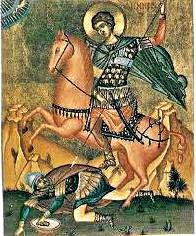
Siege of Thessalonica (I) |
year: 586September 586 |
| Unsuccessful siege by the Slavs with the help of saint Demetrius | ★ ★ ★ ★ ★ |
|
enemy: Slavs
|
location: Modern Thessaloniki, Northern Greece
|
accuracy:
●●●●●
|
|
battle type: Siege |
war: Wars against Avars & Slavs |
modern country:
Greece |
| ▼ The Byzantines(emperor: Maurice (Mauricius)) | ▼ The Enemies | |
| Commander: | Unknown | Unknown |
| Forces: | Unknown | 100,000 |
| Losses: |
| Background story: |
| Large scale Slavic settlement in the Balkans began in the late 570s and early 580s, when perhaps 100,000 Slave poured into Thrace and Illyricum. Following sweeping Avar raids along the Danube Valley to the Black Sea, Slav tribes moved across Thrace towards Constantinople. As Emperor Maurice's forces were tied down in a war against the Persians, he could muster only a small army against the Avars and Slavs. As opposed to the Persian front, the Illyrian theatre offered little possibility for a soldier to bolster his pay by pillaging, thus making fighting there rather unattractive. Maurice's badly motivated troops found it difficult to achieve even minor and local success. Rather an exception, a victory won by Comentiolus on river Erginia near the Anastassian walls (in the outskirts of the capital) in 584 and in 585 near Adrianoupolis and thus deflected the Slavic incursions to Greece, away from Constantinople. |
The Battle: |
 Saint Demetrius The events of the siege are known from only one source, the First Book of the Stories of the Miracles of Saint Demetrius, written by the Archbishop of Thessaloniki, Ioannes I, at the beginning of the 7th century. (At the time of the siege, the bishop of Thessaloniki was not Ioannes, but Eusebius.) According to Ioannes, the army of the barbarians numbered about 100,000 men. There were not many soldiers in the city, while the governor (the Perfect of Illyricum) was absent. Many of the inhabitants were also absent because it was the harvest season. The defense relied more on a kind of militia that improvised without a plan and hierarchy. In addition, the defenders were decimated by the plague (the epidemic had ended 50 days before). It should be noted that many Jews and pagans lived also in the city. We know this because an important part of the defenders was the paganikon (pagan group) of the militia. According to Ioannes, Saint Demetrius, the patron saint of the city, appeared on the ramparts dressed as a warrior and instilled courage in the hearts of the defenders and fear in the enemy. The siege that lasted a week failed and the salvation of Thessaloniki was attributed to the saint. |
Noteworthy: |
| In the narration of the miracles, Ioannes records that the arrival of the Slavs outside the walls happened on September 22, Sunday. This date corresponds to two possible years: 586 or 597. Most historians accept 586 but there are several arguments in favor of 597. So the year is not entirely certain. |
Aftermath: |
| After the end of the siege, Thessaloniki suffered from famine due to the looting of the food supplies and of the crops by the Slavs. After their failure in Thessaloniki, the Slavs did not leave, but continued to the south, while a part remained in Macedonia. Thessaloniki repeatedly became a target of the Slavs in the following decades. |
|
|
